Snorkeling UV Protection Guide

The Complete Guide to Snorkeling UV Protection
One of the most overlooked factors when snorkeling in a tropical locale is the intensity of the sun. Have you ever had an amazing experience laying in the water watching fish and corals dance below only to discover hours later when you get home that your entire backside is the color of cooked lobster? This guide can help prevent this from happening to you!
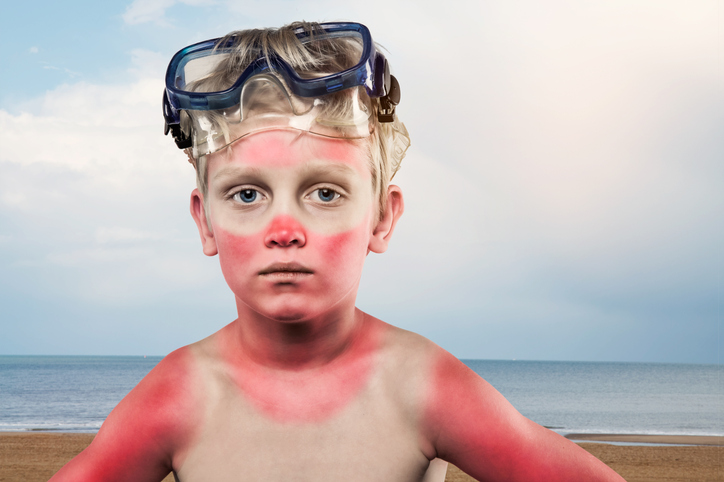
“One of the most important aspects of using sunscreen when snorkeling is to apply it a minimum of 15 minutes before going out into the sun and into the water.”
Types of Snorkeling UV Protection and Avoidance
- Sunscreen Lotion
- Clothing
- Snorkel Masks with UV Protection
- Time of Day Choice
- The Best Snorkeling UV Protection Available
- Frequently Asked Questions & Sunscreen Recommendations
Sunscreen Lotions
While humans have been using sun protection in the form of sunscreens since the time of Egyptians, the refinement of sunblock continues to improve over time. There are 2 different categories of sunscreens. Those that are called ‘chemical free’, ‘mineral’ or ‘natural’ using elements that already exist in nature, and those that contain chemicals that are created from scratch by humans.
Types of Sunscreen lotions & Sprays
- Chemical Sunscreens
- Mineral Sunscreens
- Reef Safe Sunscreens
- Spray Sunscreens

Broad Spectrum sunscreens protect against UVB (spf rating) as well as UVA rays. UVA rays penetrate more deeply into the skin.
Chemical Sunscreens
These are typically sunscreens with chemical ingredients created by humans to absorb UV radiation (light) and turn it into heat. Some will have a mix of chemicals and minerals (avobenzone & zinc oxide) while most will have only the chemical ingredients like the popular Walmart Equate brand.
Chemical Sunscreen Active Ingredients
- Active Ingredients found in Sunscreens
- Oxybenzone – banned in Hawaii
- Octinoxate – banned in Hawaii
- Octisalate
- Avobenzone
- Octocrylene
- Homosalate
- PABA – not is common use
Check out the FAQ below to learn more about the best sunscreen lotions.
Mineral Sunscreens
Mineral or chemical free sunscreen essentially means sunscreens that don’t have chemicals that were synthesized to absorb UV radiation. They almost always have rust in them. This usually means zinc oxide or titanium dioxide which are both rusted (oxidized) versions of zinc and titanium.
Back in the day when surfers used to have white or blue noses they were usually wearing zinc oxide. Zinc and Titanium both absorb UV light turning it into heat mush like chemical sunscreens. One downside of mineral sunscreens is their poor performance when it comes to absorbing UVA light.

Many sunscreen use what is called nano-zinc. This is a clear version of zinc and according to the chemical data sheet (a universal way to learn about hazardous chemicals) it is hazardous to the aquatic environment. This is why brands like Stream2Sea use the white version of zinc. While this can make your skin white it is effective and better for the environment. The trick is to use just enough and no more.
Why mineral Sunscreen?
One reason people may choose to use mineral sunscreens because they do not contain chemicals that can be absorbed into the blood. The health effects of chemically active ingredients found in sunscreen are not well known. It’s possible that they could cause irritation, hormonal-disruption, or possibly even skin cancer. Is that ironic or what? Octinoxate and oxybenzone caused hormonal changes in animals during research tests. Research on humans has not shown any effect.
Another reason people choose mineral sunscreens is for their ‘reef safe’ labeling. Unfortunately zinc oxide (ZnO) which is commonly used in these sunscreens can be toxic to the aquatic environment. It’s important to select sunscreens that have only non-nano zinc and titanium dioxide. The reason sunscreen maker will use the aquatically to
Keep in mind there is overwhelming evidence that sunscreen will protect against skin cancer and using a mineral sunscreen will provide far less protection. A mineral sunscreen that provides a high level of UVA protection has not been found.
Spray Sunscreens
If you MUST use spray sunscreen because someone has already purchased it then it’s better than nothing. But please please please consider avoiding purchasing spray sunscreen if at all possible. If it’s windy outside and you spray the sunscreen much of it will go into the breeze and not on your skin. What a waste! Don’t be that person on the beach spraying your neighbors when the wind carries your sunscreen away. Never ever spray sunscreen on a boat – it can make the deck dangerously slippery. Instead, spray on your hands and rub on your skin. Always rub the sunscreen on after spraying as it increases protection.
Benzene is a contaminant that can be found in spray sunscreens. It is a potential carcinogen. To avoid this potential hazard use lotions because they don’t contain benzene.
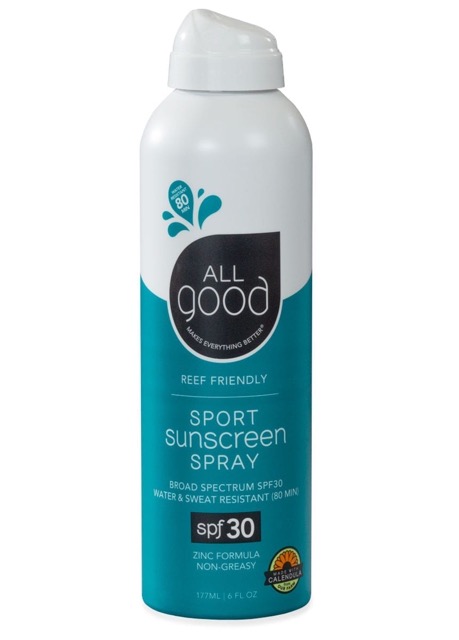
All Good makes a spray sunscreen that is actually reef safe
Application of Sunscreen
Before you apply shake the bottle. If you’re about to go snorkeling don’t waste sunscreen by putting it on places that won’t see the sun. Put it on the back of your neck, cheeks, top of forehead, lips, ears, and back of your hands only if you’re wearing a full wetsuit. Otherwise, concentrate on your backside and your head and chest which will be above the water in between laying flat in the water. You can ignore the front of your legs since they will either be underwater or facing down.
15 Minute Rule
One of the most important aspects of using sunscreen when snorkeling is to apply it a minimum of 15 minutes before going out into the sun and into the water. Keep in mind that if you put it on right before you enter the water most of it will wash off as it has not had a chance to bind to your skin. If you put sunscreen on in the sun and you get sweaty it will also have difficulty binding to your skin much like going into the water.
Re-apply
When you finish snorkeling it’s likely that even the best sunscreens have mostly come off. At this point, it is important to re-apply if you are going to remain in the sun for any extended period of time. This is often one of the biggest mistakes people make when using sunscreen as no sunscreen is truly waterproof.
Clothing
The United States Food & Drug Administration recommends using a shotglass-sized amount of sunscreen on your body every 2 hours. This is even during cloudy weather. Sounds a bit much doesn’t it? Instead of putting globs of expensive chemicals on your body consider an alternative: Clothing.
By putting on a wetsuit, sun shirt, rash guard, or lycra pants you can drastically reduce the amount of sunscreen needed when snorkeling or just chilling on the beach.
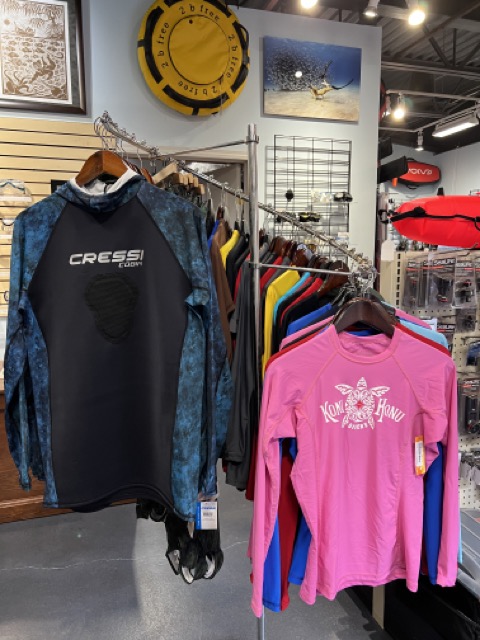
Your Local dive shop like Kona Honu Divers has a large selection of sun protective clothing available.
Types of clothing for Snorkeling UV Protection
Full Wetsuit
This is the best option for snorkeling uv protection since it will cover 95% of your body. It’s the most common outfit for freedivers because not only does it protect you from sun it also keeps you warm, protects you from scrapes and bumps, and keeps you safely and comfortably floating on the surface while resting up between dives.
Sun Shirt
Not all sun shirts are created equal. There are cheap poorly cut ones made of scratchy material and nice soft cool ones that fit tight around the wrists so you can snorkel and swim without catching water up your sleeves. Our favorite sun shirt is made by Anetik. Our crew wears them every day. They look good, feel good, and fit right.

Rash Guard
A rash guard is designed to wear in the water and typically won’t be as comfortable as a well-made sun shirt out of the water. They are typically thicker and sometimes come with pads or neoprene in the chest to protect from rash created by laying on a board. They should fit snugly on your arms to prevent them from rolling.
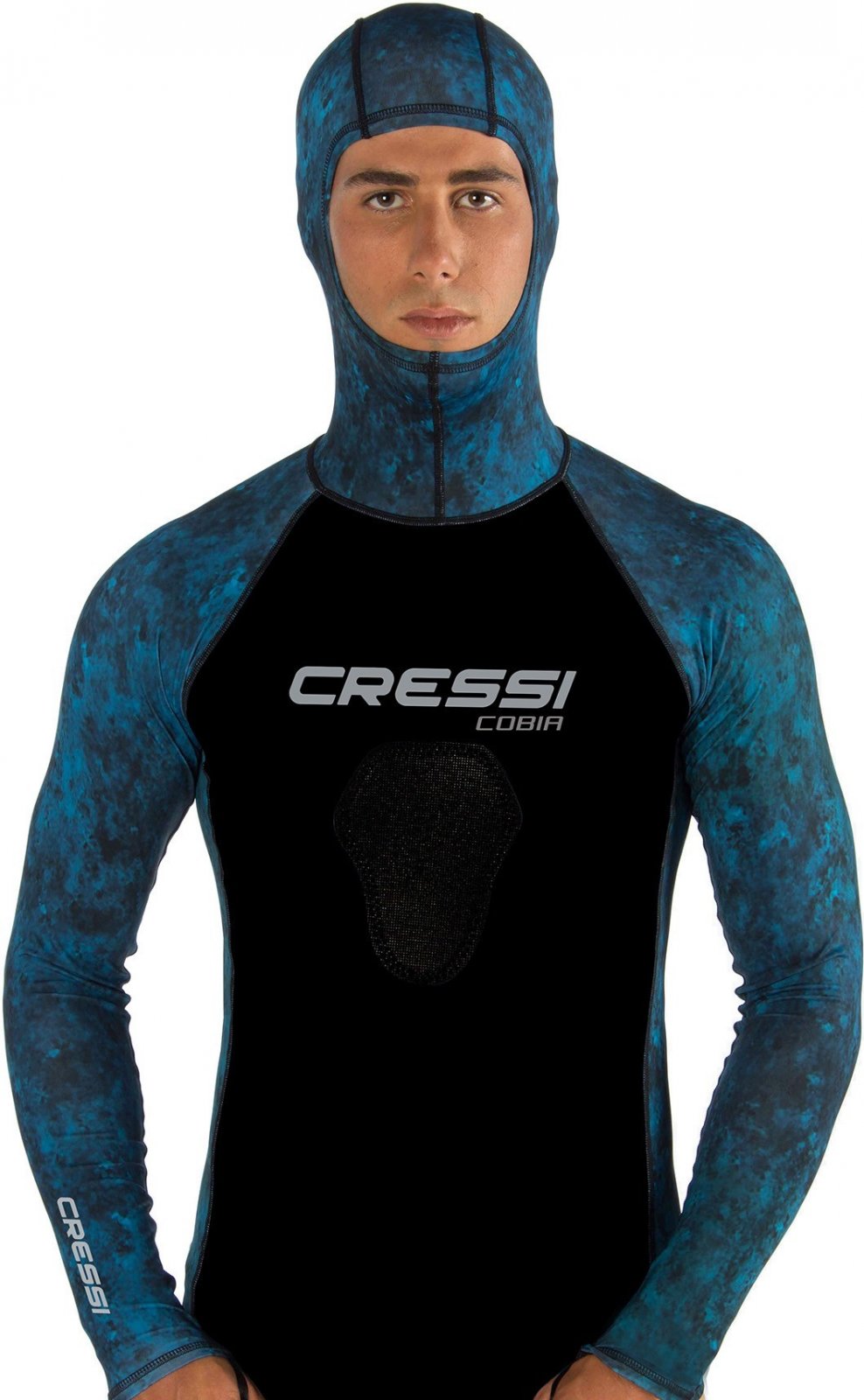
Leggings
The latest trend in wearing pants in the water is becoming more and more popular as the range of options continues to explode. Polyester/Spandex pants by brands like Spacefish Army not only look really great they are comfy, protect from scrapes or scratches, and provide SPF50 level UV protection.

Gloves
Gloves will protect the back of your hands from UV. They will also protect your hands from getting injured or scraped up when snorkeling. This is especially the case when getting in and out of the water where there is the largest potential to come into contact with the reef or shore.
Snorkel Masks that Protect From UV & HEV
Photo-keratosis (sunburn of the eye) can be caused by exposure to UV rays. This can be especially bad when out on the water with light reflecting off the water’s surface or off the hull of a boat. HEV or high energy visible light has the potential to damage your eye’s retina. With proper lens treatment masks can reduce the amount of HEV light.
Most dive and snorkel masks come with tempered glass lenses. But do these lenses block the UV light that the sun creates and can damage our vision? TUSA, one of our favorite makers of dive and snorkel masks builds UV treatment into some their lenses. Some block UV rays under 400nm (UVA & UVB) and others like the amazing TUSA Paragon block from 420 down. Most sunglasses will block light from the 400nm down.

The TUSA Paragon S mask is an example of a mask with built-in UV blocking technology
Keep in mind that when you are underwater looking at fish, reef, etc. the water is filtering the UV light. But UV is able to penetrate the water further than any other spectrum of light.
Time of Day Matters
During the peak of the daytime (usually noon) the sun is at it’s highest. This is when there is the least amount of atmosphere to filter out the UV radiation hitting the ground. Therefore you will get burned faster. If you can avoid snorkeling in the middle of the day it is best. Plan your day so you’re out and about early in the morning or later in the afternoon. This will reduce the amount of UV radiation you are exposed to. Plan to have lunch and take it easy in the middle of the day. Read a book in the shade.
UVA vs UVB
UVB rays are blocked more by the atmosphere so they are strongest from 10 AM to 4 PM while UVA rays are present throughout the day. This is why it’s important to cover up or use sunscreen regardless of the time of day as long as there is daylight.
The Best Snorkeling UV Protection
So after reading all of this information let’s distill it down. How can we go snorkeling while still being healthy? It’s as simple as avoiding the sun.
How to Avoid UV while snorkeling
- Avoid snorkeling around mid-day
- Cover up while out in the water
That’s it! For those areas that are exposed to the sun use a moderate amount of sunscreen if you’ll be out snorkeling for long periods of time. What is a long period of time? It’s difficult to say but it’s based on duration, how much sun there is in your area, and your skin tone. So if you’re going snorkeling for an hour in Australia (where there’s a hole in the ozone layer) and you have light skin, it’s probably best to use a good sunscreen on the small amount of skin exposed to the sun that’s not covered up.
The best cover for snorkeling will be a full body wetsuit or a rash guard that includes a hood. Here in Kona, Hawaii where the sun can be pretty intense we would likely use a 2mm wetsuit or a set of Bare Exowear.
Frequently Asked Questions
Do I need to use sunscreen while snorkeling?
Yes, if you don’t want to get sunburned on exposed skin. Snorkeling is similar to laying on the beach on your stomach. If you will get sunburned in 20 minutes of laying in full sun on the beach it may only take slightly longer to get sunburned while snorkeling. Check out our recommendations for how to avoid getting sunburned.
Can you get a sunburn underwater?
Yes. UV rays penetrate deep into the water. Animals like hammerhead sharks get suntans causing their top side darker than their bottom side. Check out the chart below.

Sharks living underwater can get a suntan due to the UV rays penetrating deep underwater.
What is the best Bang for the Buck Sunscreen that is also Reef Safe?
Most ‘Reef Safe’ ‘Reef Friendly’ or similarly labeled sunscreens are not actually reef safe. Unfortunately, the current state of the research on the effects of chemicals on reefs still lacks standardization. This makes it difficult to assess what chemicals are bad for reefs in what amounts and why. It has been established that basically all of the chemical sunscreen ingredients are not reef safe and even the zinc & titanium oxide used in most sunscreens is actually toxic to the aquatic environment. So to make things simple organizations like save the reef have developed guides on which sunscreens are truly reef safe.
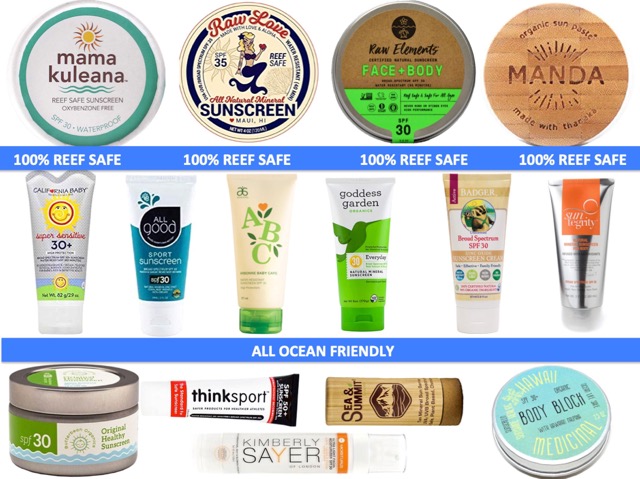
Truly ‘Reef Safe’ Sunscreen Brands
Top Budget Friendly Reef Safe Sunscreens
- All Good SPF 30 $4.67/oz
- Badger SPF 40 $5.27/oz
- Raw Elements SPF 30 $5.66/oz
- Amavara SPF 30 $5.76/oz
- Stream2Sea SPF 30 $6.32/oz
What are the top recommended sunscreens for protection?
It’s best to use a sunscreen that is less than 3 years old because even the best sunscreens ingredients can begin to lose effectiveness. The FDA requires an expiration date to be put on all sunscreens usually 3 years. Here are the current recommendations from Consumer Reports an independent laboratory test delivered these top performers. They are not all reef safe so compare to the list by Save the Reef ( see above) before purchasing.
CR tests sunscreens by applying an even amount to a grid on the backs of human test subjects. They then immerse themselves in a water bath and lay under a sun simulator. Afterward, the resulting skin redness is measured. UVA blocking is measured by smearing the sunscreen on a plastic plate and passing UV light through. Then the amount of UV light that is absorbed is measured.

Consumer Reports Recommended Sunscreen Lotions
- La Roche-Posay Anthelios Melt-In Milk Lotion SPF 60 (73 Rating)
- Equate (Walmart) Ultra Lotion SPF 50 (Best Buy)
Consumer Reports Recommended Sunscreen Sprays
Who is most at risk for sunburn and skin cancer?
If you have been spending years in a cave and have light almost translucent skin you are a prime candidate for sunburn as well as the accompanying potential for skin cancer. If you have freckled skin you may also be a good candidate for skin cancer. If you got sunburned a lot before the age of 8 you are a prime candidate for skin cancer.
What Factors Affect how easily I will sunburn?
There are several factors that will determine how quickly you will sunburn while snorkeling.
- Snorkeling UV Protection – the more protection you have the longer it will take to get sunburned.
- Time of Day – The closer to noon the faster you will burn
- Proximity to Equator – closer to the equator means more sun
- Time in the Sun – The longer you stay out in the sun the sooner you will burn
- Skin Pigmentation – the lighter your skin the quicker you will burn
If I have dark skin do I still need to wear sunscreen?
While more pigmentation in your skin will help to block UV radiation it will never block all of it. People with darker skin do not burn as easily but they can still get skin cancer. They are just less likely to get it. If you’re in the sun a lot or for long periods of time, it is especially important to wear sun protection.
Who should use sunscreen?
Anyone older than 6 months who goes outside. This includes cloudy days. Any Sunscreen is better than no sunscreen. Skin cancer is the most common type of cancer in the U.S.
What is SPF rating?
Sun protection factor is a rating or scale that classifies how much UVB light is blocked or more importantly gets past the sunscreen you are wearing. Keep in mind no sunscreen rating is truly accurate and will always overstate the amount of light it blocks sometimes by a large amount with some sunscreens only delivering a tiny fraction of the claimed SPF rating.
SPF Rating
30 allows 3 percent of UVB rays through
50 allows 2 percent of UVB rays through
100 allows 1 percent of UVB rays through
How Deep does UV light penetrate into the ocean?
UV light can penetrate 50 meters or much greater into the ocean under clear skies and open ocean conditions. Ocean water absorbs the least amount of ultraviolet and blue light of the entire spectrum of light. So at certain deeper depths, a diver will only see ultraviolet and blue light.

More Snorkeling Related Guides
Do you have to Wear Fins When Snorkeling?

